by William Kherbek // May 17, 2024
“Desire is a disaster,” Frieda Toranzo Jaeger states in her interview with Jessie Robertson, the curator of the exhibition ‘A future in the light of darkness’ at Modern Art Oxford. It is a succinct summation of our moment in history, wherein a Babel Tower of irreconcilable desires are rapidly hurtling humankind towards destruction. Jaeger is referring to works from the exhibition featuring stylised hearts broken open into panels and displayed on the gallery floor. These heart disasters, or heart crashes, provide a powerful metaphor for Jaeger’s philosophical project, but also an emotional centre for an exhibition richly infused with art historical concerns and futurity. These hearts are painted with iconography that populates Jaeger’s exhibition more broadly: car interiors, warm reds and forms that evoke stellar surfaces or energy cores. There is, inevitably, a soupçon of JG Ballard in the air, but while many artists who reference Ballard these days foreground the dystopian currents of his works, Jaeger seems tapped into the less heralded Romantic Ballard, whose capacity to depict longing and desire were as profound as his jaundiced eye for conjuring the ways in which humans would bend technological advances to their most base urges. Jaeger goes beyond wearing her heart on her sleeve, however, externalising and disembodying them completely, but they feel all the more living for it. They are religious icons of a kind perhaps, but for religions no one has yet dreamed of.
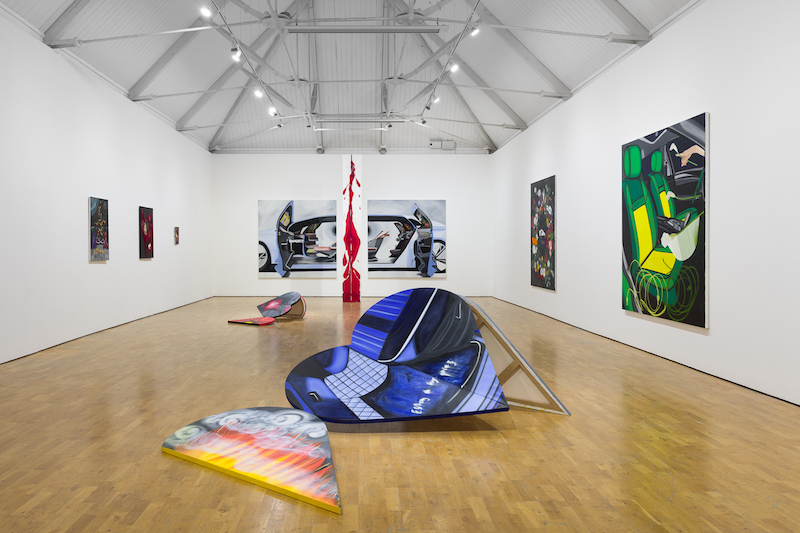
Frieda Toranzo Jaeger: ‘A future in the light of darkness,’ 2024, installation view // Courtesy of the artist and Modern Art Oxford, photo by Rob Harris
The florid—literally—open-hearted works Jaeger creates are not merely materialised wishes, but they also directly reference forms and artists from the past, particularly Lucas Cranach and Diego Rivera, as well as the interlocking narrative structures in Medieval European altar pieces. I admit to having struggled with Jaeger’s works in commercial gallery exhibitions in the past, but the space provided by Modern Art Oxford allows her arguments and the scale of her works to come fully into their expressive totalities.
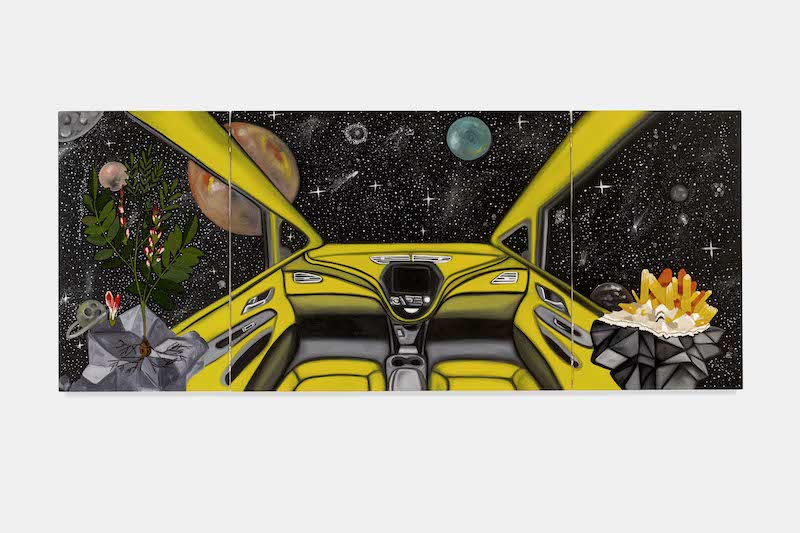
Frieda Toranzo Jaeger: ‘If the future is full of death, the past is the only alternative source of inspiration to the traditions and memories of a zombified world,’ 2023 // Courtesy of the artist, Galerie Barbara Weiss, Berlin and Bortolami, New York
Visitors will see the signature canvases featuring the helms and visual displays of spaceships, rocketry and luxury cars. Previous to this exhibition, I wondered about the narratives they were depicting and the aesthetics they were embracing. Were they perhaps buying too easily into accelerationist dreams of better living through circuitry? Jaeger addresses concerns such as these head on in her interview with Robertson, noting that the homogenised, blanched, Steve-Jobs-ified aesthetic of the “futuristic” is both racialised and militarised in insalubrious ways. Jaeger places the viewer in the driving seat of many of the works, gazing out on a windscreen of distant stars or heaving jungles, occasionally receiving flowers from the passengers window.
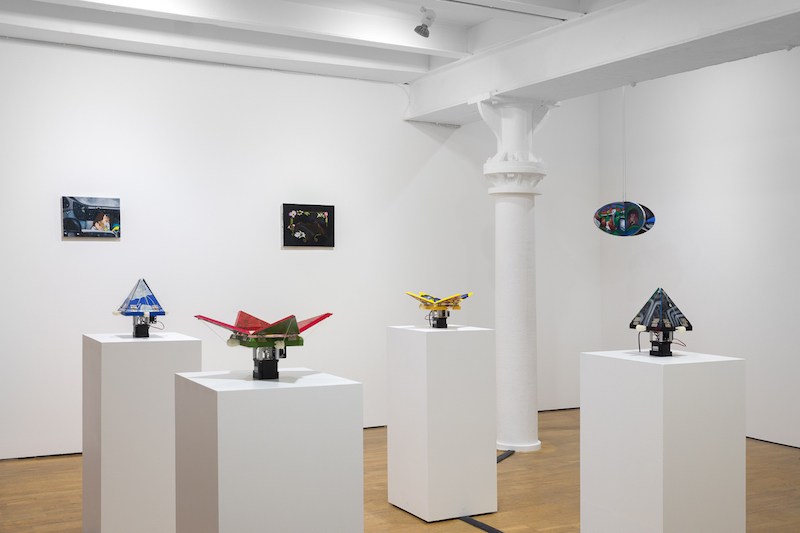
Frieda Toranzo Jaeger: ‘A future in the light of darkness,’ 2024, installation view // Courtesy of the artist and Modern Art Oxford, photo by Rob Harris
Seeing these works in the presence of her wider oeuvre, their narratives became vastly enriched. For example, the curious standing canvas structures at Modern Art—something between an obelisk and a ship’s binnacle—which blend art historical images with futuristic backdrops and structures seemed to supply a piece that had been missing in earlier exhibitions of Jaeger’s works I’d seen. Indeed, these spatial interventions seemed to “complete” the other works somehow and to locate the ecologies embedded in her practice. Jaeger’s images themselves depict sites of image display; screens (both analog and digital) appear across the works. Car windows mysteriously display images inside themselves, creating an almost hallucinatory spawning of imagery. This is, of course, the story of art: images beget images. Jaeger is perhaps positing that such image generation is as natural as other forms of reproduction. Images only need a place to appear and they will come.
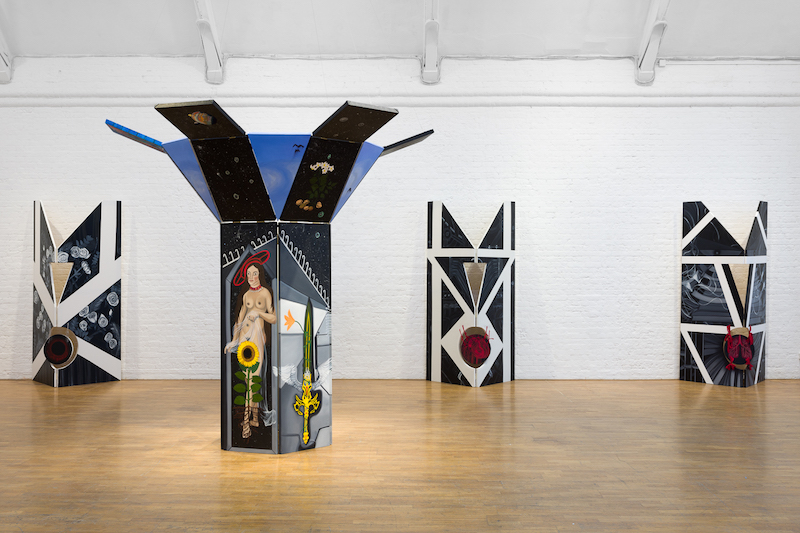
Frieda Toranzo Jaeger: ‘A future in the light of darkness,’ 2024, installation view // Courtesy of the artist and Modern Art Oxford, photo by Rob Harris
Such ecologies are sometimes more literally realised, as in a suite of mechanised boxes referencing various art historical takes on “the four seasons.” In the works, cubes with seasonal depictions open and close by means of a motorised engine. They blend the futuristic, the organic and the oneiric in an almost hypnotic polyrhythm as they grow and shrink.
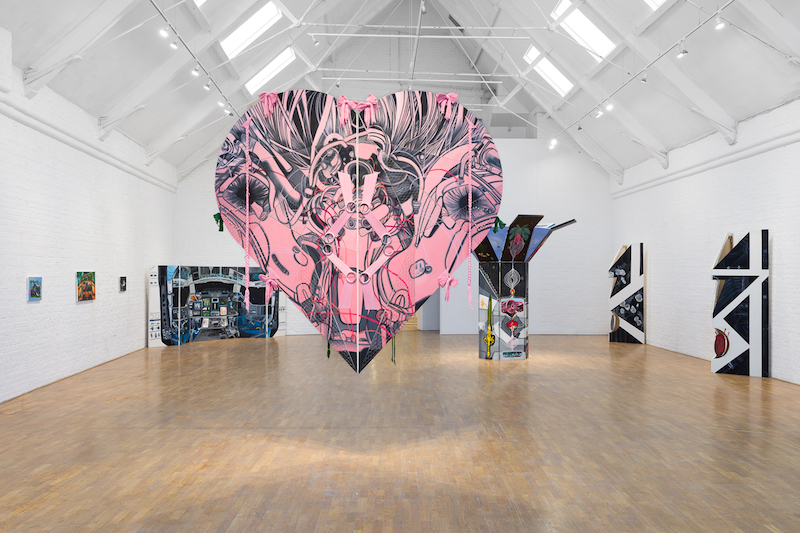
Frieda Toranzo Jaeger: ‘A future in the light of darkness,’ 2024, installation view // Courtesy of the artist and Modern Art Oxford, photo by Rob Harris
The hearts, though, perhaps more than anything, raised the stakes of the Modern Art exhibition to an even more intense pitch. Hearts are everywhere in Jaeger’s works. They’re splayed on the floor of the exhibition room. They’re strung into a space at the bottom of a structure that appears to depict engine cylinders. They’re floating into the darkness of space as two hooded and robed figures play some unfathomable game of intergalactic Double Dutch. And there’s a massive heart overhead as the visitor enters the space. The frontispiece of this heart is green and adorned with the iconography of the car engine again, on the back a mixture of pink harness straps, and images that are quasi-technological and quasi-organic, tendrils and voids, Lee Bontecou and Celia Vicuña, but most of all Jaeger herself. ‘A future in the light of darkness’ is as good an introduction to Jaeger’s works as could be hoped for. Perhaps surprisingly it is an even richer experience for those already familiar with the works, as it is the rare occasion she is allowed the physical space for her works to fully flower.
Exhibition Info
Modern Art Oxford
Frieda Toranzo Jaeger: ‘A future in the light of darkness’
Exhibition: Mar. 16-May 26, 2024
modernartoxford.org.uk
30 Pembroke St, Oxford OX1 1BP, UK, click here for map






















